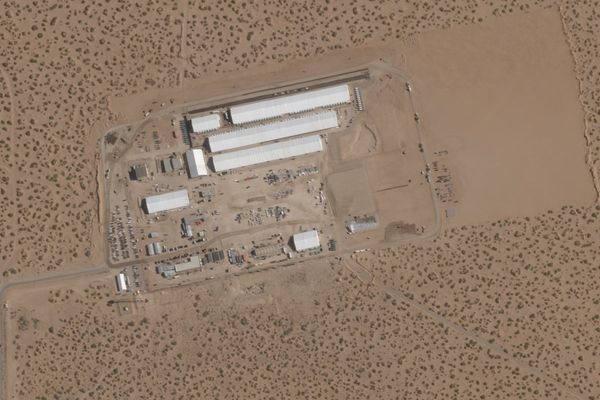
When the sculptor Grenville Davey won the Turner prize in 1992 the Guardian described him as the “rank outsider”. The Wall Street Journal was even blunter in its headline: “Brit Art-Prize Fiasco: Grenville Who?” The media bewilderment was in part because Davey, who has died suddenly aged 60, beat the favourite, Damien Hirst, to the award.
Nor did Davey make particularly good tabloid column inches. When Hirst eventually won two years later he claimed he spent the prize money in one night behind the bar at the Groucho Club in Soho; Davey told reporters his plan was a “couple of days off” and beyond being grateful for the cash prize, “what I have to say is probably not worth anything. I think there will be turkey on the table this Christmas.”
His work proved less flashy too. While he was part of the same generation of YBAs (young British artists) who attended Goldsmiths’ College (now Goldsmiths, University of London) in the late 1980s, Davey’s work possessed a beguiling austerity at odds with the more flamboyant sensationalism of his peers. On news of Davey’s death, Hirst, a friend, acknowledged the debt he held to the artist. “Without Grenville Davey there would have been no YBAs. Grenville was the first artist to truly inspire my generation … his cool surreal circles directly led to me making my spot paintings.”
At the Turner prize exhibition at Tate Britain, the artist exhibited Hal, two steel columns, each just under 2.5 metres in height. Like much of Davey’s work, Hal triggered associations with mundane, everyday objects – either oversized drinks cans or undersized industrial chimneys – but with details removed or altered.

Davey had been nominated for the prize in part for an exhibition a year earlier at the Lisson gallery in London, where his work fitted with the gallery’s interest in the minimalism of a previous generation of British artists, such as Richard Long and John Latham, as well as Americans such as Carl Andre and Donald Judd. The younger artist took their pared-down aesthetic and interest in repetition and infused it with a slightly more “pop” edge.
Untitled Pair (1987) features what might be two domestic satellite dishes, painted immaculately with a turquoise sheen, hung at different heights. The enigmatic painted steel and rubber Grey Seal (1987) resembles a big porthole cover.
While Davey continued to exhibit regularly, as well as immersing himself in public and architectural commissions, the press would not leave alone the idea of his supposed obscurity. In 2011 one critic asked: “Where is Grenville Davey now? Come to that, who is Grenville Davey?”
Davey himself was sanguine, refusing to play the fame game required of artists in the 90s. “Things got really noisy – I just had to get away. There was interest in the press, people recognised me in the street, in the pub. It was good to get away,” he said, swapping his Brixton studio in a condemned former fish and chip shop for a farm in rural Essex. From there he took on more collaborative commissions.
These included a permanent public artwork for the Olympic Park in east London, commissioned in 2011. Inter Alia consists of 61 trapezoid brass markers that jut from a wall, each identical but with a series of rings on the facing surface, likened by Davey to fingerprints. They were, he said, “reminiscent of the finger in the icing, on an industrial scale”.
While accessible, the sculptures were developed through a highly theoretical framework. In 2010 Davey had undertaken a six-month residency at the Centre for Research in String Theory at Queen Mary, University of London, working with the physicist David Berman to draw out parallels between the theoretical geometries within string theory and Davey’s own longstanding interest in symmetry. Continuing the project as an artist-in-residence at the Isaac Newton Institute for Mathematical Sciences, Cambridge, Davey exhibited a series of maquette works at Chelsea Space in London in 2014 that referenced the concepts of T-duality and mirror symmetry.

Grenville was born in Launceston, Cornwall, to Lillian, a nurse, and Clifford Davey, who was in the Royal Navy Engineers and later became a police officer. After attending Launceston college, Davey did a foundation fine art course at Exeter College of Art and Design, then a fine art degree at Goldsmiths’.
In the final year of art school, before graduating in 1985, he discovered the workshop with its metalworking equipment. “I was shy of it at first but got over it,” Davey recalled. “That’s where things started to take off.” After being included in a group exhibition at the Showroom gallery a year later, in 1987 he had his first solo show at the Lisson.
In 1988 he was included in the Venice Biennale and a year later Charles Saatchi bought works, which, given the collector’s outsized influence at the time as tastemaker, placed Davey on a trajectory to success.
Institutional shows followed at the Stichting De Appel Foundation in Amsterdam (1990), the Kunsthalle, Berne (1991) and, after his Turner win, the Chisenhale gallery in London (1992).
In 1996 Davey undertook the first of many public commissions, working with landscape architects to develop public seating at Newcastle Drawdock, a neglected boat landing on the River Thames in east London. Two years later a pair of site-specific sculptures for the offices of the Dr Martens shoe factory in Northamptonshire was unveiled.
His interest in the public realm continued into the new millennium, and he collaborated on civic redesigns in Manchester city centre, Barnsley, Stockton and Middlesbrough.
In 1998 he began teaching at the University of the Arts, London, and in 1999 at the University of East London, where he remained until his death, becoming head of the MA fine art course in 2009.
He is survived by his son, Sennen, from his marriage to Victoria (nee Burton), a sculptor, which ended in divorce in 2015, a stepson, Charles, and three brothers, Graham, Chris and Adrian.
• Grenville Clifford Davey, artist, born 28 April 1961; died 28 February 2022







